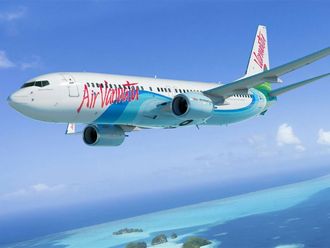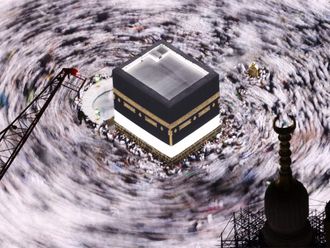KIEL, Germany: On June 28, 1914, Kaiser Wilhelm II was preparing to indulge in a favourite pastime: racing his yacht Meteor at a regatta that is still held each year in this seafaring stronghold. When he learnt of the assassination in Sarajevo of Archduke Franz Ferdinand, the heir to the Habsburg Empire, he hastened to Berlin. But he quickly returned to this Baltic Sea port, on which he lavished so much money and time in his frantic race to match or outdo British naval superiority.
In many ways, Kiel epitomised Germany’s rapid industrialisation and militarisation from 1870 to 1914, under Otto von Bismarck and then the kaiser. Numbers alone tell a story: In 1870, as Bismarck unified Germany, Kiel had around 30,000 inhabitants. By 1914, when Europe’s leaders stumbled into First World War, its population exceeded 227,000.
Four years later, Kiel bore witness to the depths of German defeat. A sailors’ rebellion that started here spread nationwide and helped force the abdication of the kaiser in November 1918. The next year, rather than let the Imperial Fleet fall to the enemy, German commanders on Scapa Flow, off Scotland, scuttled 52 of the fleet’s 74 vessels. Under the Treaty of Versailles, signed five years to the day after the archduke’s assassination, the proud navy was limited to just a few ships and 15,000 men — far fewer than the 35,000 German sailors who had perished in World War I.
Might, militarism and humiliation: These are the memories that make Germans today reluctant to project their clout as, once again, Europe’s economic powerhouse. One hundred years on from First World War, German leadership in Europe is both desired and resented, a historically rooted ambivalence that is keenly felt by the Germans and by their wary neighbours.
Most Germans remain reluctant to see their country’s force deployed in any way commensurate with its economic heft. But this abstention from military action does not mean that Germany is not throwing its weight about.
During the European debt crisis, Chancellor Angela Merkel demonstrated that no solution was possible without Germany’s helping hugely to pay for it. Always calm, she brooked little criticism and brushed aside anti-German sentiment as she pushed to impose austerity on supposedly profligate European neighbours.
Today, with nationalism and populism on the rise in Europe, Merkel is central in trying to untangle a tussle over European leadership that may hasten a British exit from the European Union, and she faces demands from two other major partners, France and Italy, to relax stringent budgetary demands.
In Germany, the enormity of Nazi crimes in Second World War tends to overshadow First World War, which consumed more than 37 million lives, including those wounded and missing, and four empires. In some ways, the 100th anniversary has reminded Germans that Hitler and his supporters bore deep scars from the country’s catastrophic defeat in 1918. Germans are observing the occasion with about 80 exhibitions nationwide, and with countless discussions and seminars. ‘The Sleepwalkers’, Christopher Clark’s chunky history of how Europe went to war in 1914, is a best-seller and its author a coveted guest for centenary discussions.
In Kiel, the imperial stamp always lingered. A statue of Kaiser Wilhelm I on horseback adorns a central park. The Kiel Canal, to this day an important waterway linking the North and Baltic Seas, was named after Wilhelm II when it opened in 1895. Outsize paintings of the opening still stare down at the regal Kiel Yacht Club.
Paradoxically, it was development on land that helped bolster the importance of this natural deep-sea port. By the time of Bismarck, the growth of railways had brought goods and people to Kiel from all over Germany and enabled the delivery of imports throughout the newly unified country. Later, shipyards that had produced Germany’s first submarine in 1851 were central to Wilhelm II’s naval race with Britain.
Especially after 1900, Wilhelm poured torrents of money into the German navy. In 1906, Britain’s Royal Navy took delivery of HMS Dreadnought, with its groundbreaking armament of big guns. Wilhelm and top members of his navy and government responded with plans to build two dreadnoughts and one battle cruiser per year, as well as to dredge and widen the Kiel Canal so the large new vessels could use it.
Four battle cruisers were produced in Kiel from 1907 to 1910, completed ahead of schedule. Naval spending rose steadily at least until 1912, when military commanders came to consider a land war more likely.
Britain and France were alarmed by Wilhelm’s ambition. Britain’s determination to keep its navy supreme only heightened German anxieties, already running high because the kaiser felt beleaguered on two fronts. The huge Russian army ensured that his perceived foes had more men under arms than Germany and its Austro-Hungarian allies could muster.
In some sense, his naval expansion may have been a salve for this insecurity. At any rate, the Reichskriegshafen Kiel, the imperial war harbour here, profited. By the time war broke out in 1914, the navy had 22 pre-dreadnought ships, 14 dreadnoughts and four battle cruisers.
Three more warships were completed by November 1914, and construction continued throughout the war, with a battle cruiser added in late 1914, 1916 and 1917. Naval historians, however, tend to accord more significance to Germany’s U-boats, which were responsible for the sinking of the Lusitania in 1915, for instance, eventually helping to draw the United States into Europe’s Great War.
A similar shipbuilding boom erupted in the 1930s after Hitler took power and reached an agreement with Britain, ushering in a new wave of production of submarines and surface battle vessels. The shipbuilding made Kiel a prime target for Allied bombs, and by the end of the war in 1945, it was 80 per cent destroyed.
Today, Kiel is still a seafaring town. Submarines are still built here. Sailors bob on Kiel Sound. Instead of dreadnoughts and battle cruisers, hulking cruise and cargo ships dominate the urban shoreline. But the city is a mosaic of ill-matched architecture and buildings that have changed purpose. Wilhelm’s proud Naval Academy, for instance, is now the parliamentary seat of Schleswig-Holstein, the state of which Kiel is the capital. The mishmash lends a defeated air to a place still pondering how to remember and interpret a dreadful 20th century.
The histories of two concrete memorials illustrate the scars. One was originally intended to honour Germany’s naval dead in First World War. The other is the Flandernbunker, or Flanders bunker, built outside the main surviving military base here. Its name stems from a Nazi campaign to lionise the Germans killed in the World War I trenches, and it sheltered military commanders and select civilians in the global conflict that ignited two decades later.
Today, a local art historian, Jens Ronnau, runs the bunker as an alternative arts and conference centre with a goal of teaching peace and how to avoid future wars.











